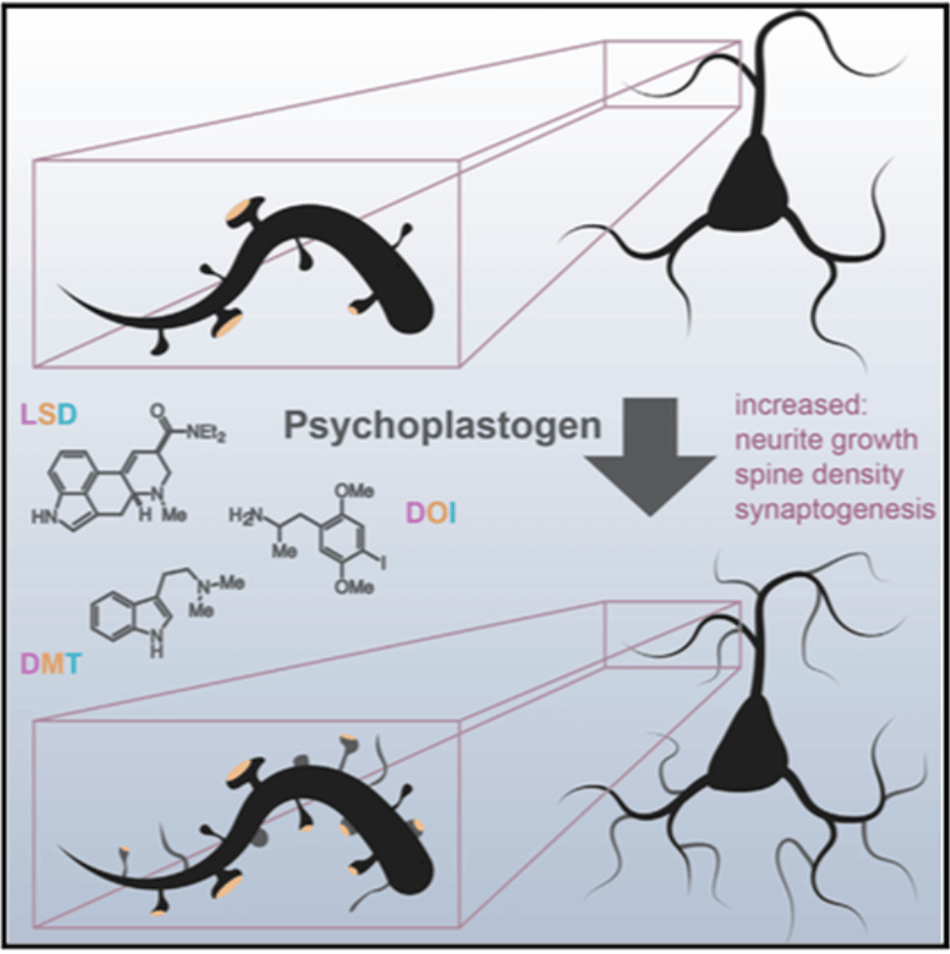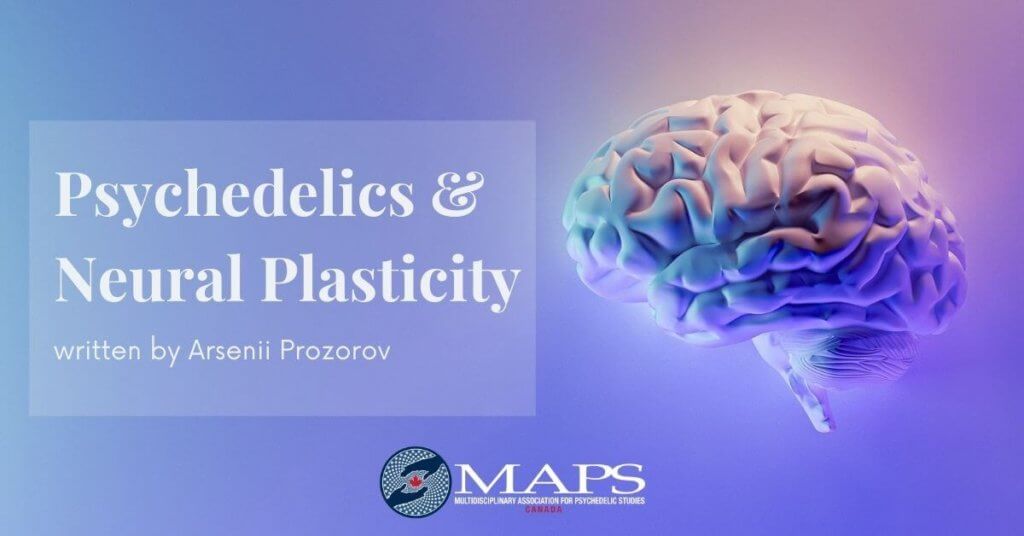Neural plasticity has been the subject of much debate, and hype both in the scientific community as well as the general public. At the same time, research into the transformative potential of psychedelics has exploded. There are multiple avenues that scientists are using to understand how mind-altering substances work on the brain. One of them is looking at how molecules interact on the smallest biological scale and then by using a bottom-up approach analyze the effects of those interactions to elucidate the nature of psychedelic experiences. This could also help to answer whether the psychedelic experience is necessary to create neural plasticity.
What is neural plasticity, and why is it so important?
Neural plasticity is the capacity of the nervous system to modify itself, functionally and structurally, in response to experience or injury [1]. Some may refer to this plasticity as the growth of new neurons, or neurogenesis. While neurogenesis is involved in neural plasticity, its importance and benefits are a topic for a different discussion.The more studied and understood type of neuroplasticity is the plasticity of existing brain networks. This change of existing connections between neurons is the cellular mechanism by which we remember and forget. Through our understanding of these mechanisms, we could understand how our memory functions. In fact, scientists have been able to erase and implant memories in mice [1].

So, what does plasticity have to do with psychedelics?
In attempts to answer how psychedelics affect neurons and the brain, several studies have been undertaken. The results of these studies indicate that psychedelics can enhance neural plasticity, through the development of the parts of the neurons that give them their iconic tree-like appearance and interconnections between them (dendritic branches and synapses respectively) [2]. Unfortunately, only a few of these studies involved human subjects and placebo controls. It may be too early to laud psychedelics as the future of neuroplasticity. Most receptors impacted by psychedelics are situated in the cortex, particularly in the prefrontal cortex, which is associated with human-specific abilities, such as impulse control and planning [3] [6]. However the studies were done with rodents that have a much smaller prefrontal cortex proportional to the body size [4], therefore when it comes to the effects of the psychedelic induced plasticity in humans, more research is urgently needed.
Dosage and relative effects were not adequately tracked, which could have indicated that higher quantities of psychedelics would or would not produce higher levels of neuroplasticity. “In some trials, mice received 10x higher doses than the average person would, which makes the task of determining non-psychoactive benefits even harder. There is also the possibility of initiating too much neuroplasticity, known as excitotoxicity, whereby neurons become damaged due to overstimulation. However, even with the lack of human research, science hints towards the beneficial effects of psychedelics on the nervous system on a physiological level. Interestingly, studies have shown genes related to neuroplasticity were triggered following administration of psilocybin [3], some of which initiate a cascade of gene transcriptions to our DNA. On the other hand, some of the genes which had been switched either on or off are also responsible for excitotoxicity. The beneficial outcomes are possibly dependent on the amount and frequency of consumption (among other factors), however the questions of dosage, and a deeper understanding of the molecular mechanisms involved is desperately needed
Memory, personality, and plasticity
Memory is an ability of the brain to encode, store, and retrieve information when needed. For the brain to be able to encode and store information, long term changes in the connections between neurons have to occur. Neural plasticity allows for those long term changes, and therefore it functions as the neurobiological mechanism of memory. However, by thinking in broader terms, we could say that everything we consider ‘us’ is a consequence of memory. Any attempt to define ego is based on personal experience and impressions, with neuroplasticity being the mechanism by which our experience shapes our perception.
Psychedelic effects are primarily localized in the serotonin receptors in the cortex. Hence they do not affect the whole brain equally, and only boost plasticity of specific regions. By identifying these regions and their functionality, scientists can better understand how they interact to create psychedelic experiences. Dr. Robin Carhart-Harris, a researcher at the Imperial College of London, attempts to answer these questions with his REBUS model [5], which deserves a separate article.
Science is just beginning to glimpse into the abstract notions of the self with psychedelics, and hope to use these tools to better understand what “self” means. Despite the great promise of these substances to treat mental illness and broaden our understanding of the human mind, there are numerous obstacles that await psychedelic research. These obstacles include legislation that restrict access to psychedelics and a lack of research funding that hinders meaningful progress. However, researchers are hopeful that this renaissance in psychedelic studies will prompt a new revolution in psychiatry [6].
References
[1] S. T. Sheena A. Josselyn, “Memory engrams: Recalling the past and imagining the future,” Science, vol. 367, pp. 1-14, 2020.
[2] G. A. C. L. e. a. Ly C, “Psychedelics Promote Structural and Functional Neural Plasticity,” Cell Rep., vol. 23, no. 11, pp. 3170-3182, 2018.
[3 ] E. B. W. G. M. H. 2. N. 4. d. 1. E. a. o. p. Jefsen OH, “Transcriptional regulation in the rat prefrontal cortex and hippocampus after a single administration of psilocybin.,” J Psychopharmacol. , vol. 4, no. 269881120959614, 2020.
[4] Schaeffer DJ, Hori Y, Gilbert KM, Gati JS, Menon RS, Everling S. Divergence of rodent and primate medial frontal cortex functional connectivity. Proc Natl Acad Sci, vol 1;117(35), pp. 21681-21689. 2020
[5] F. K. Carhart-Harris RL, “REBUS and the Anarchic Brain: Toward a Unified Model of the Brain Action of Psychedelics.,” Pharmacol Rev, vol. 71, no. 3, pp. 316-344, 2019.
[6] Nature Reviews Drug Discovery 20, 418-419 (2021)
[6] E. T. W. a. R. Andrade, “Htr2a gene and 5-HT2A receptor expression in the cerebral cortex studied using genetically modified mice,” Front. Neurosci., vol. 4, no. 36, pp. 1-12, 2010.

